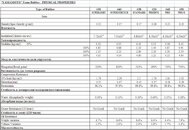АлександрД
Contributor
Once we discussed about minimal BCD volume for neoprene wetsuit. Some guys told that just 2 L is enough (to compensate air weight in tank).
Some use just marketing and experience, and told like for most BCD - 10-14 L. Some told about 30 L ...
So, I offer you my estimation for minimal volume of BCD. Any remarks or corrections be welcome! Also mathematics and phisics: Welcome for discussion!
Lets go...
(I will use many assumptions, but our target - just to receive estimation of measured weight)
I will use Decimetre, as standard length in my counts, because easy to convert - 1dm3 = 1 L of water = 1 kg
Spherical cow in vacuum ... Ups, sorry, .... intermediate diver body surface is around ~1.9m2 = 190 dm
Lets count buoyancy loss for worst conditions, and we will use 9mm neoprene thikness. (0.09dm)
Total neoprene volume 190*0.09=17.1 dm3
When it consists vacuum only - it will have buoyancy 17 kg, BUT! it has also Neoprene inside.
Neoprene density is around 150-250 kg/m3 (same as g/dm3)

ok, will use 0.2 kg/dm3 as medium
It mean that suit weight is around 17*0.2=3.4 kg (it is just weight of Neoprene itself, like a rubber)
And buoyancy of that suit is 17-3.4= 13.5 kg (approx)
It means that all our suit contain 13.5 L of air.
Once I counted formula of piped depthmeter and got this
V(current)=V(total)*10/(10+depth)
Will use maximal allowed recreational depth - 40m
V(at 40) = 13.5 * 10 / (10 + 40) = 13.5 * 0.2 = 2.7 l
Sure, J-Y Cousteau used rubber suits with glass spheres inside rubber, to prevent compression, but we have just Neoprene... so, for worst condition we will allow, that Neoprene not elastic, but has not crushing resistance.
It mean that we loss from surface till 40m around 13.5-2.7=10.8 kg of buoyancy.
BTW: Neoprene itself (as rubber, without air foam) has dencity around 1.5 g/cm, (1.5 kg/dm)
It mean that "sinkancy" (neoprene itself, without air) is around 3.4*(1.5-1) = 1.7 kg underwater weight.
Theoretically at 70m we will have just 1.68 L of air inside neoprene foam, and our suit start to be sink!
All this calculation means - you should not have BCD less than 11 L of air.
Global conclusion: Use drysuit!
Some use just marketing and experience, and told like for most BCD - 10-14 L. Some told about 30 L ...
So, I offer you my estimation for minimal volume of BCD. Any remarks or corrections be welcome! Also mathematics and phisics: Welcome for discussion!
Lets go...
(I will use many assumptions, but our target - just to receive estimation of measured weight)
I will use Decimetre, as standard length in my counts, because easy to convert - 1dm3 = 1 L of water = 1 kg
Spherical cow in vacuum ... Ups, sorry, .... intermediate diver body surface is around ~1.9m2 = 190 dm
Lets count buoyancy loss for worst conditions, and we will use 9mm neoprene thikness. (0.09dm)
Total neoprene volume 190*0.09=17.1 dm3
When it consists vacuum only - it will have buoyancy 17 kg, BUT! it has also Neoprene inside.
Neoprene density is around 150-250 kg/m3 (same as g/dm3)

ok, will use 0.2 kg/dm3 as medium
It mean that suit weight is around 17*0.2=3.4 kg (it is just weight of Neoprene itself, like a rubber)
And buoyancy of that suit is 17-3.4= 13.5 kg (approx)
It means that all our suit contain 13.5 L of air.
Once I counted formula of piped depthmeter and got this
V(current)=V(total)*10/(10+depth)
Will use maximal allowed recreational depth - 40m
V(at 40) = 13.5 * 10 / (10 + 40) = 13.5 * 0.2 = 2.7 l
Sure, J-Y Cousteau used rubber suits with glass spheres inside rubber, to prevent compression, but we have just Neoprene... so, for worst condition we will allow, that Neoprene not elastic, but has not crushing resistance.
It mean that we loss from surface till 40m around 13.5-2.7=10.8 kg of buoyancy.
BTW: Neoprene itself (as rubber, without air foam) has dencity around 1.5 g/cm, (1.5 kg/dm)
It mean that "sinkancy" (neoprene itself, without air) is around 3.4*(1.5-1) = 1.7 kg underwater weight.
Theoretically at 70m we will have just 1.68 L of air inside neoprene foam, and our suit start to be sink!
All this calculation means - you should not have BCD less than 11 L of air.
Global conclusion: Use drysuit!



